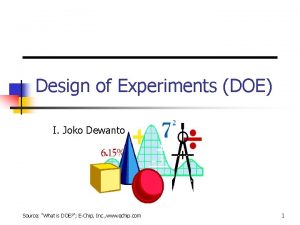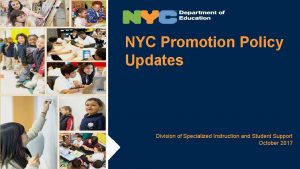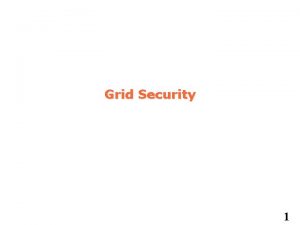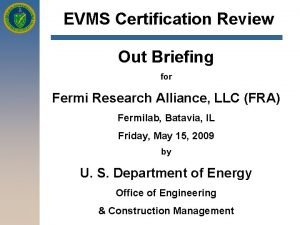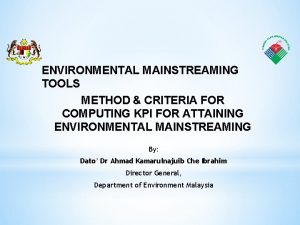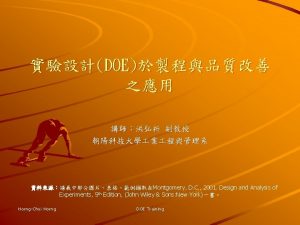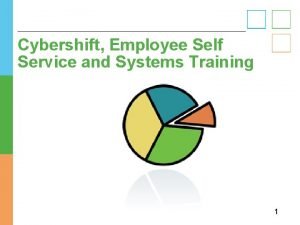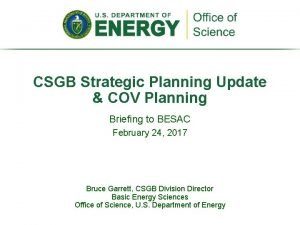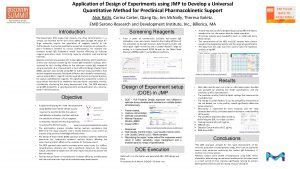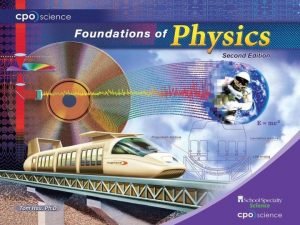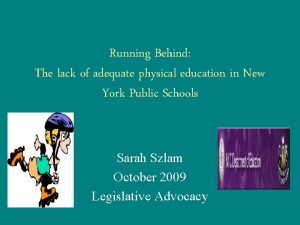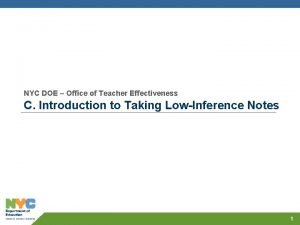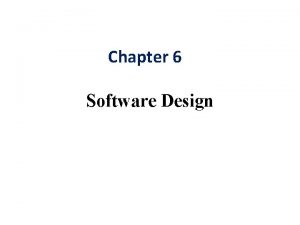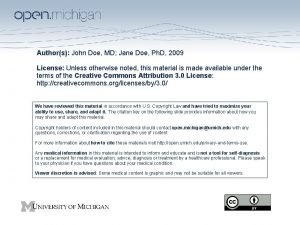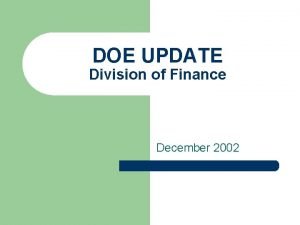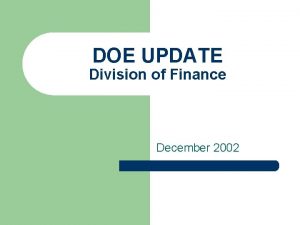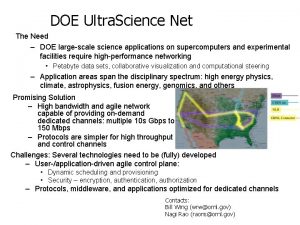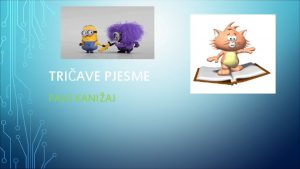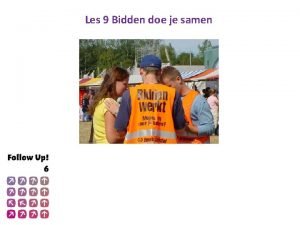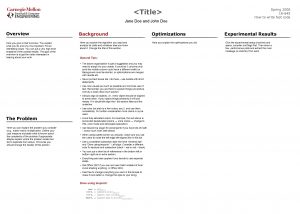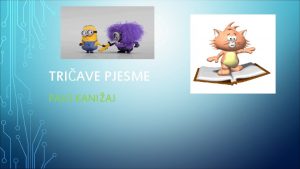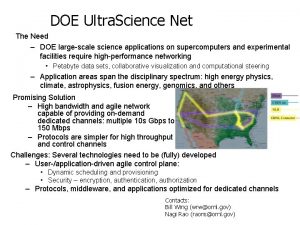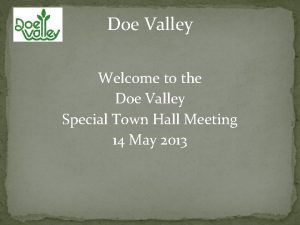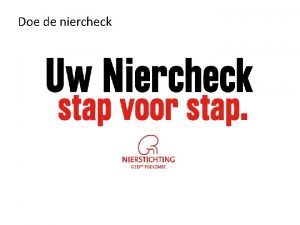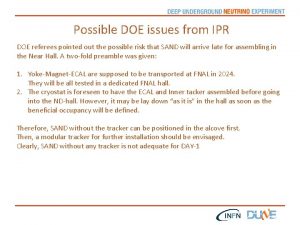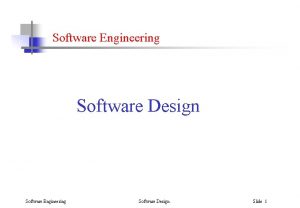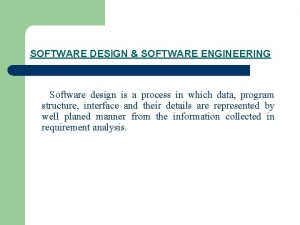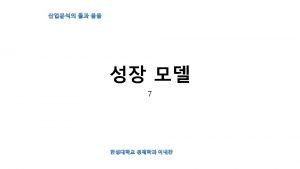How To Design Your Model DOE Software Design





























- Slides: 29

“How To Design Your Model”

DOE Software Design of Experiment www. statease. com üThis EASY TO USE software has all the major experimental designs (general ANOVA, two-level full and fractional factorials, three-level factorials, several RSM designs, mixture designs, and much more). üMore and more features are added with each new version of the software. ü It has powerful graphical tools and it has been featured in several well-known texts on DOE. Apparently it has been WIDELY USED IN INDUSTRY. üThe web site provides excellent DOE resources and one can download a 30 -day full version from the web site.

DOE Wisdom www. launsby. co üThis software also claims that it offers PRACTICALITY and EASE-OF-USE that is IDEAL FOR BEGINNERS but with the computing power demanded by advanced users. üIt basically offers VERY SIMILAR FEATURES TO DESIGN-EXPERT with the addition of the Pareto chart and a few other minor differences. üOne can DOWNLOAD A 15 -DAY FULL VERSION of the software for the web site. DOEpack www. pqsystems. com üThis standalone software available also FEATURES THE USUAL CLASSICAL AND TAGUCHI DESIGNS with a wide selection of SCREENING DESIGNS, PROCESS OPTIMIZATION DESIGN AND ANALYSIS TOOLS. ü It has good graphical tools and an intuitive user

www. jmp. com üThis standalone DOE software is developed by the well-known SAS Institute, developers of the SAS program. üThis is also powerful software and provides design choices for almost every situation. Perhaps the additional feature that is not available in the other software is that the user can perform custom designs which give the experimenter the most flexibility. üObviously, this feature is ONLY USEFUL FOR THE EXPERT USER. Limited time free download of the software is also available from the JMP web site.

Design Expert Version 7. 1. 5 or LATEST Version 8

Doe Vocabulary Factor One of the independent variables under investigation that can be set to desire value K Number of factors or variables the effect of which are to be estimated in an experimental Level The numerical value or qualitative feature of a factor Run The act of operating the process with a factors at certain setting Response The numerical result of a run Factor Experiment Design to determine the effect of all possible combinations across all level of the factor under study Factorial Designed to examine k factors with the fraction of the runs required for a full factorial Blocking A strategy for designing experiment to provide the ability to eliminate from the experimental error a contributor of variability that is known but not under investigation

Why Goes For Experimental Design? 1 EFFICIENCY Get more info from fewer experiments 2 FOCUSING Collect only info that really needed üis a useful complement to multivariate data analysis. üwith designed experiments there is a better possibility of testing the significance of the effects and the relevance of the whole model.

DOE Flowchart? 1 4 7 Set your objective Select your design Fit & Diagnose Model 2 Select Input Factors 3 Select Output Response 5 8 Develop your strategy Interpret Model 6 9 Run Experiment Confirm Model Will be explain next semeste r

Building a Experimental Design ! Your Final Year Project Titles Example: Studies Of Potential Parts Of Streblus asper (Kesinai) For Protease Production 1 DEFINE THE OBJECTIVE of the investigation: e. g. “sort out important variables” or “find the optimum conditions To screen and identify the POTENTIAL PLANT PARTS of PROTEASE PRODUCTION from Streblus asper by using Design of Experiment

Building a Experimental Design ! 2 SELECT INPUT FACTORS that will be controlled during the experiment (design variables), and their levels or ranges of variation. Weight of your sample (g) Ratio (mol) (Buffer : Sample) Time of Extraction (minutes) 3 SELECT OUTPUT RESPONSE that will be measured to describe the outcome of the experimental runs (response variables), and examine their precision Enzyme Activity (unit/m. L)

Building a Experimental Design ! 4 SELECT YOUR DESIGN CHOOSE among the available standard designs the one that is compatible with the objective, number of design variables and precision of measurements, and has a reasonable cost

Screening Design The Screening designer supplies a list of popular screening designs for 2 or more factors. Screening factors can be continuous or categorical with two or three levels. The list of screening designs also includes designs that group the experimental runs into blocks of equal sizes where the size is a power of two.

WELCOME! 1

2 START YOUR DESIGN!!

Choose The Experimen tal Design 3 4

The choices appear in color on your screen. White squares symbolize full factorials requiring 2 k runs for k (the number of factors) from 2 to 9. The other choices are colored like a stoplight: GREEN FOR GO, YELLOW FOR PROCEED WITH CAUTION, and RED FOR STOP, which represent varying degrees of resolution: ≥ V, IV, For a quick overview of these color codes, press and III, respectively. the screen tips button (or select Tips, Screen Tips) and click topic 1: “What type of information do you want? ” This design builder offers full and fractional two‐level factorials for 2 to 21 factors in powers of two (4, 8, 16…) for up to 512 runs.

8 Insert your range here! Make sure the range is not too small or too big 7 Insert your factors and unit 9

Temperature Numeric Pressure Factors Categoric Catalyst Type Automotive Model

10 11 Choose number of response in your study Insert your response here! 12

Actual Values!!!! 14 Insert your experimental data here 13 List of experiment that you design before will be shown here 5 6 Develop your strategy Run Experiment

15 You might choose process factors in coded or actual

You’ve put in some work at this point so it is a good time to save it. The quickest way of doing this is to press the standard save icon. But you can also go to the File menu and select Save As. Type in the name of your choice for your data file. Then click Save.

For Plackett Burman minimum factor is 11. Design If your factors is less than 11, you add dummies factors to complete it. Next step is the same as previous.

Response Surface Design Response Surface Methodology (RSM) is an experimental technique invented to find the optimal response within the specified ranges of the factors. These designs are capable of fitting a second order prediction equation for the response. The quadratic terms in these equations model the curvature in the true response function. If a maximum or minimum exists inside the factor region, RSM can find it. In industrial applications, RSM designs involve a small number of factors. This is because the required number of runs increases dramatically with the number of factors. The Response Surface designer in JMP lists well-known RSM designs for two to eight continuous factors. Some of these designs also allow blocking

CENTRAL COMPOSITE design, combines a two-level fractional factorial and two other kinds of points: Fractional factorial point Axial Point Centre Point Axial (or star) points, for which all but one factor set at zero (midrange) and one factor set at outer (axial) values. Center points, for which all the factor values are at the zero (or midrange) value. The BOX-BEHNKEN design, is an alternative to central composite designs. One distinguishing feature of the Box-Behnken design is that there are ONLY THREE LEVELS PER FACTOR. Another important difference between the two design types is that the BOX-BEHNKEN DESIGN HAS NO POINTS AT THE VERTICES OF THE CUBE defined by the ranges of the factors. This is sometimes useful when it is desirable to avoid these points due to engineering considerations. The price of this characteristic is the higher uncertainty of prediction near the vertices compared to the Central Composite design.

1 Insert your optimize factor and your range here Number of run 2

Insert list of response involved in your optimization here 3

Actual Values!!!! 5 Insert your experimental data here 4 List of experiment that you design before will be shown here 5 6 Develop your strategy Run Experiment

Thank you…. .
 Design of experiments doe
Design of experiments doe Give us your hungry your tired your poor
Give us your hungry your tired your poor Real time software design in software engineering
Real time software design in software engineering Software design fundamentals in software engineering
Software design fundamentals in software engineering Department of energy oig
Department of energy oig Efq framework
Efq framework Sd doe mentor program
Sd doe mentor program Rti screens
Rti screens Modified promotion criteria nyc doe
Modified promotion criteria nyc doe Nyc doe lodi
Nyc doe lodi Homophone for exercise
Homophone for exercise Jane and john smith
Jane and john smith Doe order 420
Doe order 420 John doe drivers license
John doe drivers license Doe 413 evms
Doe 413 evms Environmental mainstreaming tools
Environmental mainstreaming tools Melissa klembara
Melissa klembara Doe sustainability dashboard
Doe sustainability dashboard Doe ecrp
Doe ecrp Doe montgomery
Doe montgomery Doe electrical safety handbook
Doe electrical safety handbook Cybershift codes nyc doe
Cybershift codes nyc doe Doe cpims
Doe cpims Jmp design of experiments
Jmp design of experiments Information about light
Information about light Https serp doe louisiana gov ser
Https serp doe louisiana gov ser Nyc doe fitnessgram
Nyc doe fitnessgram Doe white paper
Doe white paper Julie carruthers doe
Julie carruthers doe Nyc doe office 365
Nyc doe office 365
